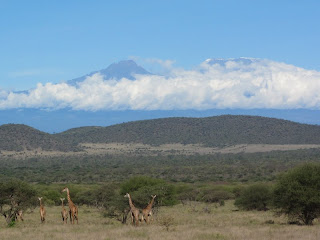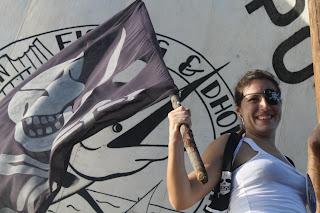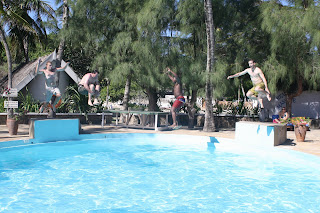I got back to Kenya right after Easter and jumped right into “full speed ahead” mode. Work wise, things are cranking up - I am leading a capacity assessment of the KMD (the met department) and it’s pretty much consuming my life (in a good way). The purpose of the capacity assessment is for our team to get a better idea of the KMD’s capabilities, both in meteorology and IT. The KMD Is going to be a crucial part of our project’s implementation, and so we need to understand their abilities before we start the project. While I was home, I was working on getting the scope defined, finding people to conduct the assessment, and in general laying the groundwork for the effort. Now that I’m back in Kenya, it’s time for the actual assessment to start. Basically, this just means a lot of meetings between Dr. Nyenzi (the expert who is conducting the assessment)/myself and the KMD team. It’s a bit stressful - our client from the US is also here, which adds to the coordination effort. Meetings, coordination - these are the types of things that are fairly easy in the States - you schedule a meeting, and you can be reasonably certain that everyone will show up. Here, everything is a wild card - you might schedule a meeting, and folks might never show up, or there might be terrible traffic and you have to reschedule, or (as was the case this week) there can be a petrol shortage and no one can get anywhere - almost anything can and will happen. I know it’s not the most difficult work, I’ve just self imposed a lot of stress - I need to make sure that everyone is in the right place at the right time and that we are getting the results we need within the time we need them - we only have two weeks to complete the work.
As I mentioned previously, most of the assessment effort is conducting meetings with the various KMD departments to get an understanding of their current processes and working with them to identify gaps and weaknesses. One of the areas we wanted to understand more was the KMD’s regional offices and how they interact with local farmers (farmers are, after all, the focus of our project). To support this, I (with the help of others) organized a visit out to Machakos, which is a region just south of Nairobi. The goal of the day was to meet with the KMD’s regional team in Machakos to understand how they work and what our project can do to improve the services that they provide. We also met with farmers in the area (a local co-op of 25 farming families) to understand what types of weather information they receive today, and what additional information they need in the future. Finally, we met with the local Ministry of Agriculture extension workers - these are individuals that are at the grassroots level, working with farmers and educating them about new ways to plant and increase their yields.
It was an incredible day, one that really opened my eyes to the situation that the rural people face in Africa - there is just such a need for help/improved ways of living. At the same time, it was amazing to see what people are able to do with such limited resources. For example, the KMD and the Ministry of Agriculture produce a seasonal advisory - this one page sheet contains information about the expected rainfall for the season, and pairs that information with agricultural advice - for example, the prediction is that it is going to rain less than normal, so farmers should plant X types of seeds and use X type of fertilizer. Right now, the co-op that I mentioned receives 8 PRINTED copies of this document - and they have to use it to educate the 1000+ farmers that live in the area. To get from place to place, they use 3 bicycles that were donated almost 10 years ago. It’s a daunting task, yet they are doing it....and it’s working. Farmers who hear the information in those bulletins are seeing an increase of 60% in their yields. Incredible, yet true. I learned so much on this visit, but the main themes were:
- Water dependency - Africa is so dependent on water. We have to find ways to reduce this dependency, be it through irrigation, changing the types of crops that are grown, and develop other, innovative ways to reduce the need for consistent weather patterns
- Fancy technology is not always the answer to the problem - the more we meet with people, the more we realize that the majority of the farmers we want to reach use radio and face to face meetings with extension workers to get their information. There are definitely opportunities to use mobile technology to push out information, but we cannot overlook the “simpler” channels, as they form a big part of rural life
- Support, education and training are going to be critical success factors for our project - there is a lack of knowledge about how weather works, the probability factor in weather forecasts, and how to translate weather information into actionable advice. If we don’t get the education and training part of this right, everything else will be for naught
Vicky and I spent the ride home talking about all we had seen, and how we need to modify our plans and recommendations to account for the things we learned on the visit. It was definitely one of the “game changing” days for our project. Hopefully, when implementation of the project starts, we’ll get the chance to work with the folks in Machakos again....the lessons they’ve taught our team today will definitely stick with us.
Here we are at the KMD's regional office and observation station. This is the place where they take the weather observations and enter them into a computer system that transmits them back to headquarters.
One of the weather instruments - when I started this project, I knew next to nothing about weather, and now I know how to read one of these things!
Our first meeting with the farmers, the KMD staff, and the Ministry of Agriculture workers. This is the 'conference room' at the KMD's offices. It was here that we learned about the agro advisory bulletin and the fact that there are only 8 copies available to educate all the farmers in the area.
After leaving the KMD, we traveled to a nearby farm to meet with a local farmer's group (similar to a co-op). We spent time talking with the farmers, learning about the weather information they receive today and how they use it. We also talked about how the distribution of weather information (and education about weather) could be improved. At first, the group was very quiet (most folks did not feel comfortable speaking in English, and were shy of talking to outsiders), but after a little prodding and lot of translation, we all started having a good conversation
After speaking with the farmers, we were taken on a tour of the farm. We got to see the ways that farmers are trying to adapt to the changing weather conditions that are plaguing Africa
Here I am with Simon Gathara (from KMD) and Mr. Muhunyu (from the Ministry of Agriculture). These two guys were invaluable at helping me set up the day and it's activities.
This is the owner of the farm, showing us the rain gauge that he maintains. The KMD has a network of "volunteer observers" (of which this farmer is one) who take rainfall measurements to help supplement the KMD's network of observation stations. These measurements are written down daily and then mailed into the KMD on a monthly basis. They are a very useful source of information, but a lack of education surrounds them - this farmer understands the value, but his neighbors often ask him why he has chosen to have a rain gauge on land that could otherwise be planted. Just another example of the education factor of this project.
Hilary with the rain gauge
Our final stop of the day was to the Ministry of Agriculture's extension offices. Here we learned about the government sponsored programs to help farmers. This is a major channel for reaching the rural communities - but the network is stretched very thin. In the past, there was one extension worker for every thousand farmers. Right now, estimates are that one worker exists for every FOUR thousand famers.
Tradition and formality are still very important here, especially in meetings. Since I was the one that organized the field visit, I was definitely looked at as the "leader" from our project team. During the ministry of agriculture meeting, I was given the seat at the head of the table (an honor) and was given the title of meeting "chairman" - hilarious, especially considering I usually do everything I can do stay OUT of the limelight at these events. Besides running the meeting, my chairman duties included signing the guest book!



































































